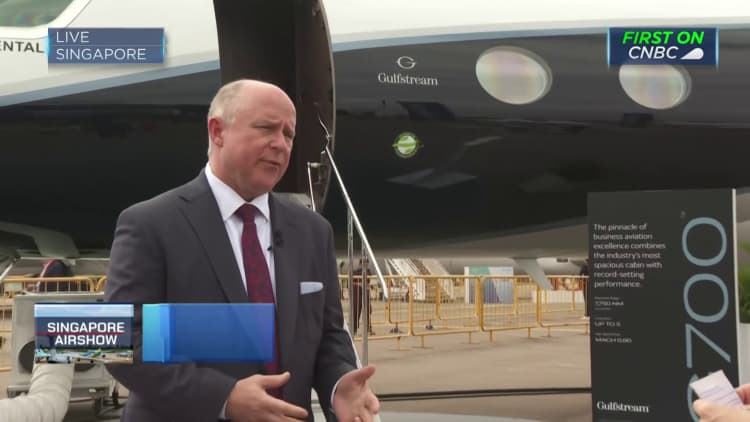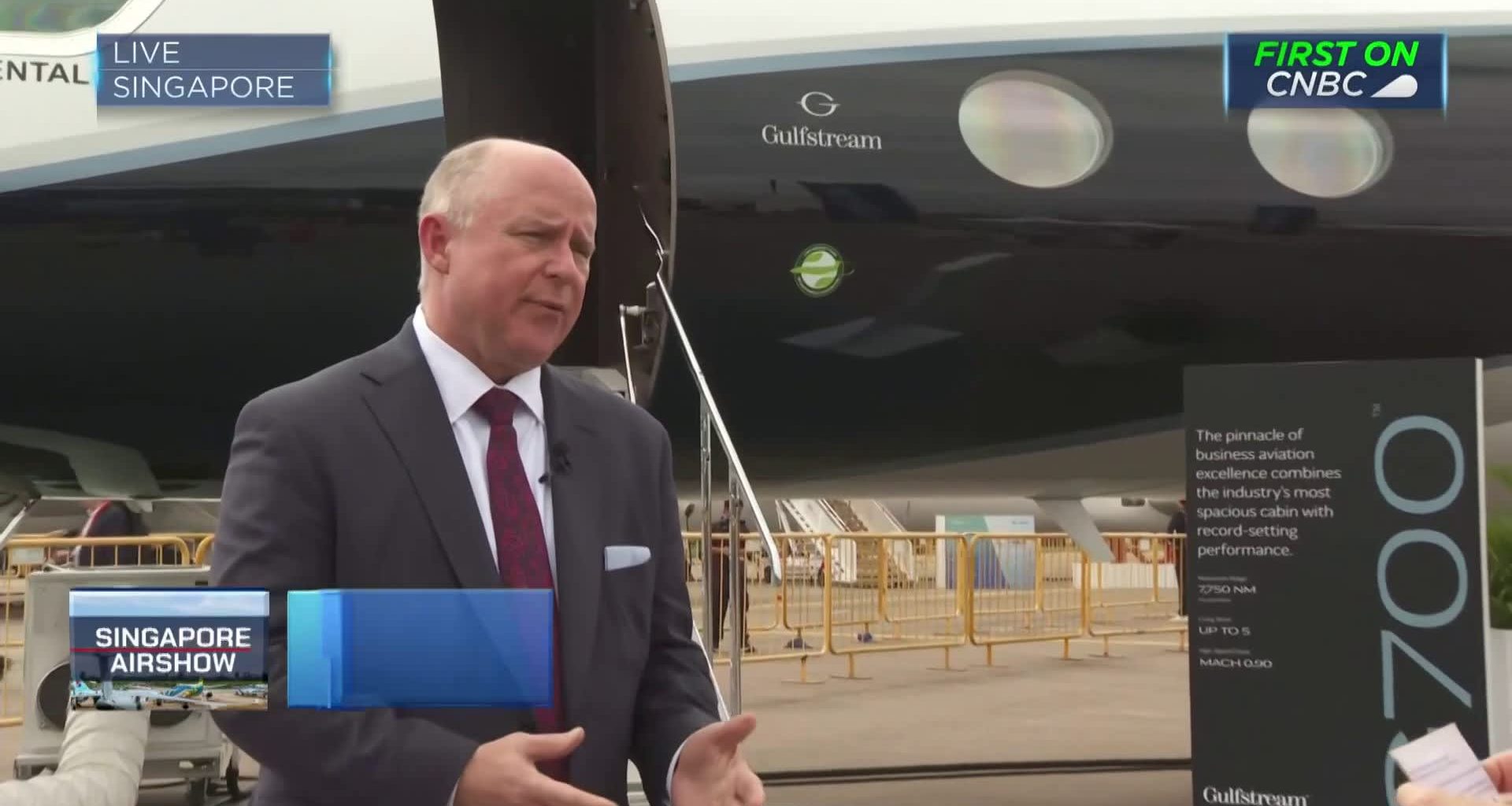A seat and a bed onbaord a Bombardier Global 6500 business jet on display during the Singapore Airshow in Singapore, on Wednesday, Feb. 21, 2024.
Bloomberg | Bloomberg | Getty Images
Planes, trains and snowmobiles comprised the transportation portfolio that Bombardier was riding as the 21st century unfolded.
But the Montreal-based company also was carrying a boatload of debt incurred while building those diverse businesses over several decades, especially the billions it poured into developing the C Series passenger jet, launched in 2008 to compete with Boeing and Airbus for commercial airlines orders.
By 2018, the financial and operational headwinds became too strong, forcing Bombardier’s then-CEO Alain Bellemare to begin shedding key assets, most prominently by selling Airbus the C Series program — rebranded as the popular A220 airline. That was followed by divesting the rest of its commercial aircraft businesses, the Learjet brand of private planes and the railway unit. The recreational products entity, featuring Ski-Doo snowmobiles and Sea-Doo personal watercraft, had been offloaded in 2003.
A new management team, headed by CEO Éric Martel and CFO Bart Demosky, took control in 2020. They immediately established an ambitious, five-year strategic plan to reposition Bombardier, with a focus squarely on its sturdiest leg: the high-flying business jet and ancillary services industry. That is proving to be a smart calculation, based not only on Bombardier’s almost 40 years of experience in manufacturing and marketing business jets but also the current state of that aviation sector.
Deliveries of business and general aviation aircraft last year topped 4,000 for the first time in more than a decade, the General Aviation Manufacturers Association reported in February. When compared to 2022, all aircraft segments saw increases in shipments, and preliminary aircraft deliveries were valued at $27.8 billion, an increase of 3.6%, according to the trade association, adding that business jet deliveries climbed 2.5%.
Bombardier’s pure-play strategy is based on four key pillars, Demosky said. The first two revolve around its highly regarded Challenger and Global business jets, both new and certified-preowned models, sold to well-heeled individuals, companies and fleet operators such as, Flexjet, Wheels Up and NetJets, the fractional-ownership unit of Warren Buffett’s Berkshire Hathaway. The third pillar is the worldwide network of aftermarket maintenance and repair centers, and finally the global defense market for retrofitted, special-mission military aircraft.
CEOs spending big on private planes
No matter who owns the jets, corporate executives have doing plenty of flying in recent years. Companies in the S&P 500 spent $65 million for bigwigs to use private jets for personal travel in 2022, up about 50% from pre-pandemic levels three years earlier, a Wall Street Journal analysis earlier this year found. CEOs benefited the most, with spending for their aircraft perks reaching a five-year high in 2022, according to executive compensation consultant Equilar. Approximately 45% of Equilar 500 CEOs received aircraft perks in 2022, while only 14.2% of CFOs received the same perk.
Of course, when the entire aviation industry was disrupted — and when commercial airlines started flying again later that year with mandated health restrictions, flight delays and airport chaos — individuals and companies that could afford to buy, lease, rent, or share business jets did, and demand soared. The post-Covid peak numbers are expected to moderate, but the growth continue over the longer-term. Honeywell said in a global aviation outlook issued last October that 2023 growth would still be 10% above the 2019 level, and demand for business jets over the next decade should remain strong.
Historically, the business jet market has been cyclical, said Noah Poponak, an analyst for Goldman Sachs, “but it’s been hyper-cyclical in the past 20 years.”
He cited the period from 2003 to 2007, when demand was high and OEMs ramped up production, only to be hit by the 2008 financial crisis. Demand collapsed and OEMs significantly cut production, leaving them with a plenty of new and used inventory. Sales of all business jets were healthy leading into 2020 — and then the Covid pandemic hit.
The best barometer for the business jet market, said RBC Capital Markets analyst Walter Spracklin, is the percentage of the total global fleet up for resale on the used market, which generally follows overall economic conditions. “That percentage is typically in the 10% to 12% range,” he said. “When it goes into 12% to 15%, that’s when we are in recession. Coming out of Covid, it went down to 3%. Everyone wanted a business jet and was willing to buy whatever was out there, new or used.”
Today, the percentage is around 6%, so the demand environment is very strong, Spracklin said.
Aircraft are assembled at the Bombardier Challenger Assembly Hall during Bombardier’s 2023 Investor Day on March 23, 2023, in Dorval, Quebec, Canada. (Photo by ANDREJ IVANOV / AFP) (Photo by ANDREJ IVANOV/AFP via Getty Images)
Andrej Ivanov | Afp | Getty Images
By staying that new course over the past three years, the company has grown revenue and earnings, reduced its massive debt nearly by half and expanded free cash flow. For 2023, Bombardier reported revenues of $8 billion, up 16% year-over-year, driven by higher deliveries and record-setting aftermarket revenues of $1.75 billion, also up 16%.
Adjusted EBITDA rose 32% from 2022 to $1.23 billion, while cash flow generation from continuing operations reached $257 million, beating the company’s 2023 guidance. “All of that cash has gone to debt retirement, which went from $10.1 billion in 2020, down to $5.5 billion last year,” Demosky said.
Bombardier delivered more aircraft than any of its peers in 2023, Demosky said, referring to OEM competitors such as Gulfstream, Embraer, Dassault and Textron. Poponak concurred, and then some. “Bombardier has been closer to their delivery targets than anybody over the last three years,” he said. For 2021, the company estimated that it would deliver between 110 and 120 jets and it hit the 120 mark. For 2022, the target was 120 jets and 124 were delivered, and last year it reached the set goal of 138 deliveries. The estimate for this year is between 150 and 155 deliveries.
How the pandemic changed aviation’s course
The pandemic upended a lot of things for Bombardier, Demosky said. Martel had been with the company from 2002 to 2015. He was president of the business jet unit when he left to run Hydro-Québec until 2020. Coincidentally, his first day as CEO was just as the world shut down, halting Bombardier’s production facilities in Canada.
“When we came back a few months later, the world had changed,” Demosky said, notably severe interruptions throughout supply chains. “Many of our peers reduced their supply chain capabilities, but we made the decision to increase ours,” based on anticipating an incremental demand for business jets coming out of the pandemic. “Being proactive allowed us to get ahead of the curve with supply chain challenges and able to meet commitments on deliveries and grow our business more rapidly and effectively than our peers,” the CFO said.
Bombardier produces three versions of two classes of business jets, the mid-size Challenger and the large-cabin, long-range Global. The largest and fastest is the 19-passenger Global 7500, capable of speeds up to Mach 0.925. An upgraded 8000 model is scheduled for release later this year. “Order activity remains very strong for both the Challenger and the Global [models],” Demosky said. “We are either number one or two in terms of sales and deliveries of medium and large aircraft in every geographic segment.”
A Bombardier Global 7500 business jet is pictured during a presentation of the brand new aircraft from the global business aviation company at Geneva airport on March 3, 2022.
Pierre Albouy | Afp | Getty Images
To help keep that growing fleet in the air, the company has expanded its aftermarket service business, now operating 10 centers spread across the U.S., Europe and Asia, and projected to generate $2 billion in revenues this year, Demosky said.
Another growth opportunity is the defense segment, which for close to 30 years has sold jets to air forces around the world. “We made the strategic decision a few years ago to invest in our capability to grow that business, not only in delivery of aircraft, but in providing other value-added services — maintenance, engineering services and modification services,” he said.
Bombardier heads into the final stretch of its five-year transformation having achieved demonstrable success as a stand-alone business jet company. Yet feedback from investors “has been very interesting,” Spracklin said. “Many, particularly Canadian investors, have had a storied past with this company, so early on, buying back into Bombardier had been met with some skepticism, but they’re converting those skeptics. It’s a work in progress, but one that is going in the right direction.”
Poponak offered a similar assessment. “Overall, the investment community hasn’t fully come around,” he said. “Any time a company and a stock go through a long period of challenges, having done some things wrong, even after they fix the issues and make it a good business, the market feels like it needs to see a multi-year window of consistently delivering [positive results] before it will divorce the company from its past. Investors are coming around, but it will probably be a few more years before they’re fully out of that,” he said.
Although Bombardier’s stock has fluctuated over the past 52 weeks, from a high of around $54 last March to a low of almost $30 in October, the company can achieve less than their guidance and still have their stock go up this year, he said.
Demosky acknowledges that at the beginning of the repositioning, “there were doubters about whether we could turn the company around and perform as well as we believed we could,” he said. “I’m pleased to say that those naysayers are now few and far between. We’ve met or beat guidance over the past 13 quarters, so I think we have the track record to support the view that we can perform. Our job is just to keep executing.”

Read More: World News | Entertainment News | Celeb News
CNBC









